Electromagnetic Induction - 6
E8. An inductor of inductance 2mH is connected across a charged capacitor of SµF. Let q denote the instantaneous charge on the capacitor, and I the current in the circuit. Maximum value of Q = 200 µC.
(a) When q = 100 µC, what is the value of |dI/dt| ?
(b) When q = 200 µC, what is the value of I ?
Ans: (a) The expression for q is q = Q coswt
where w =  = 104 Hz
= 104 Hz
Now 
(As in S.H.M.) = 108 x 100 x 10-6 = 104 A/s.
= 108 x 100 x 10-6 = 104 A/s.
(b) When the energy of capacitor is maximum the energy stored in the inductor will be zero.
=>  LI2 = 0
LI2 = 0
 I = 0 I = 0 |
M1. In the circuit diagram shown in figure R = 10
 , L = 5 H, E = 20 V, I = 2 A. This current is decreasing at a rate of - 1 A/s. Find Vab at this instant ?
, L = 5 H, E = 20 V, I = 2 A. This current is decreasing at a rate of - 1 A/s. Find Vab at this instant ?
Ans: P.D. across inductor
VL =

= 5 x (- 1)
= - 5 V
Now, Va - IR - V2 - E = Vb
 Vab = Va - Vb
Vab = Va - Vb= E + IR + VL
= 20 + 2 x 10 - 5
= 35 V
M2. A conducting rod of length l attached to a rod of insulating material of length L is rotated with constant anfular speed in a plane normal to uniform
 as shown.
as shown.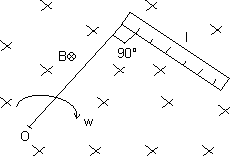
Find the e.m.f. produced across the ends of the conducting rod ?
Ans: Consider a small elemental length dn of the rod at a distance n from the end of the rod as shown.
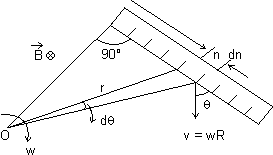
The e.m.f. across the elemental rod will be

= Bwn dn

=
 wBl2
wBl2Note: The result is same as if the rod is rotated about one of its ends.
M3. A variable magentic field creater a constant e.m.f. E in a conductor ABCDA. The resistance of the portions ABC, CDA and AMC are R1, R2 and R3 respectively. What current will be shown by meter M ?
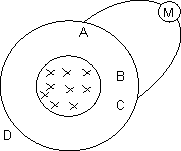
The magnetic field is ...... near the axis of the circular conductor.
Ans: Let E1 and E2 be the e.m.f.s developed in ABC and CDA, respectively.
Then E = E1 + E2
There is no net e.m.f. in the loop AMCBA as it does not enclose the magnetic field. If E3 is the e.m.f. in AMC then E1 - E3 = 0. The equivalent circuit and distribution of current is shown in figure:
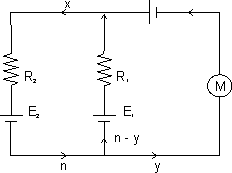
By loop rule:
R1(x - y) + R2x = E1 + E2 = E
and R3y - R1(x - y) = E3 - E1 = 0
Solving for y

M4. Two parallel vertical metallic rails AB and CD re separated by 1 m. They are connected at the two ends by resistance R1 and R2 as shown in figure. A horizontal metallic bar of mass 2 kg slides without friction vertically down the rails under the action of gravity. There is a uniform horizontal magnetic field of .6 perpendicular to the plane of the rails. It is observed that when the terminal veloity is attained power dissipated in R1 and R2n are .76 w and 1.2 w respectively. Find the terminal celocity of the bar and the values of R1 and R2?
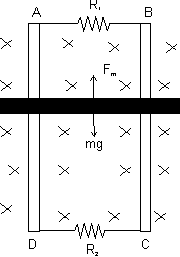
Ans: The rod will acquire terminal velocity only when magnetic force FM = BlI due to electromagnetic induction balances its weight, that is:
BIl = mg
 I =
I = 
Now, if E is the e.m.f. induced in the rod,
E x I = P = P1 + P2
So, E =
 = .6 V
= .6 VNow as this E is generated due to motion of rod with terminal velocity in magnetic field:
t = BVTl

= 1 m/s
Now, P =


Here V1 = V2 = E
